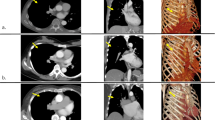Abstract
Objective
To investigate whether minimally invasive mitral valve repair (MIMVR) can be transferred from a high-volume center into a very small volume center and to clarify how many cases are necessary for maintenance of this program, early outcomes of MIMVR in Asahikawa Medical University were compared with those results in patients operated by a single surgeon in Duesseldorf University Hospital.
Methods
Sixty-five patients who underwent MIMVR in Asahikawa Medical University (group A) between May 2014 and July 2018 and 134 patients who underwent MIMVR in Duesseldorf University Hospital (group D) between September 2009 and January 2014 by a surgeon who started MIMVS later in Asahikawa were retrospectively analyzed.
Results
In group D, there were more patients with ischemic mitral valve regurgitation and with annular calcification than in group A. Survival rate at 6 months and 1 year was 98.5% and 98.5% in group A and 92.9% and 91.3% in group D, respectively. EuroSCORE II was significantly higher in patients dead within 30 days and within the first year.
Conclusions
The present study demonstrated that MIMVR programs can be transferred with acceptable early results into very low volume centers, if the team is developed by surgeons who are well trained and experienced in MIMVR. Moreover, the present study suggested that case number for maintenance of acceptable results may be obviously less than the previous recognition that this kind of specialized surgery could be maintained with at least 50 cases annually. However, meticulous preparations for surgery are essential for satisfactory surgical outcomes.



Similar content being viewed by others
References
Falk V, Cheng DC, Martin J, Diegeler A, Folliguet TA, Nifong LW, et al. Minimally invasive versus open mitral valve surgery: a consensus statement of the international society of minimally invasive coronary surgery (ISMICS) 2010. Innovations (Phila). 2011;6:66–76.
Modi P, Rodriguez E, Hargrove WC 3rd, Hassan A, Szeto WY, Chitwood WR Jr. Minimally invasive video-assisted mitral valve surgery: a 12-year, 2-center experience in 1178 patients. J Thorac Cardiovasc Surg. 2009;137:1481–7.
Loulmet DF, Carpentier A, Cho PW, Berrebi A, d’Attellis N, Austin CB, et al. Less invasive techniques for mitral valve surgery. J Thorac Cardiovasc Surg. 1998;115:772–9.
Davierwala PM, Seeburger J, Pfannmueller B, Garbade J, Misfeld M, Borger MA, et al. Minimally invasive mitral valve surgery: “The Leipzig experience”. Ann Cardiothorac Surg. 2013;2:744–50.
Beckmann A, Funkat AK, Lewandowski J, Frie M, Ernst M, Hekmat K, et al. German heart surgery report 2016: the annual updated registry of the German society for thoracic and cardiovascular surgery. Thorac Cardiovasc Surg. 2017;65:505–18.
Holzhey DM, Seeburger J, Misfeld M, Borger MA, Mohr FW. Learning minimally invasive mitral valve surgery: a cumulative sum sequential probability analysis of 3895 operations from a single high-volume center. Circulation. 2013;128:483–91.
Masuda M, Okumura M, Doki Y, Endo S, Hirata Y, Kobayashi J, et al. Thoracic and cardiovascular surgery in Japan during 2014: annual report by the Japanese association for thoracic surgery. Gen Thorac Cardiovasc Surg 2016;64:665 – 97.
Casselman FP, Van Slycke S, Wellens F, De Geest R, Degrieck I, Vermeulen Y, et al. From classical sternotomy to truly endoscopic mitral valve surgery: a step by step procedure. Heart Lung Circ. 2003;12:172–7.
Harjai KJ, Samy S, Pennypacker B, Onofre B, Stanfield P, Yaeger L, et al. Developing a new hybrid revascularization program: a road map for hospital managers and physician leaders. J Interv Cardiol. 2012;25:557–64.
Nguyen TC, Lamelas J. From the ground up: building a minimally invasive aortic valve surgery program. Ann Cardiothorac Surg. 2015;4:178–81.
Vohra HA, Vaja R, Iakovakis I, Bapat V, Szostek J, Young C. Starting out in minimally invasive aortic valve replacement in the UK. Interact Cardiovasc Thorac Surg. 2016;22:1–4.
Hunter S. How to start a minimal access mitral valve program. Ann Cardiothorac Surg. 2013;2:774–8.
Sakaguchi T. Minimally invasive mitral valve surgery through a right mini-thoracotomy. Gen Thorac Cardiovasc Surg. 2016;64:699–706.
Murzi M, Cerillo AG, Bevilacqua S, Gasbarri T, Kallushi E, Farneti P, et al. Enhancing departmental quality control in minimally invasive mitral valve surgery: a single-institution experience. Eur J Cardiothorac Surg. 2012;42:500–6.
De Praetere H, Verbrugghe P, Rega F, Meuris B, Herijgers P. Starting minimally invasive valve surgery using endoclamp technology: safety and results of a starting surgeon. Interact Cardiovasc Thorac Surg. 2015;20:351–8.
Nishi H, Miyata H, Motomura N, Toda K, Miyagawa S, Sawa Y, et al. Propensity-matched analysis of minimally invasive mitral valve repair using a nationwide surgical database. Surg Today. 2015;45:1144–52.
Author information
Authors and Affiliations
Corresponding author
Ethics declarations
Conflict of interest
The authors have declared that no conflict of interest exists.
Additional information
Publisher’s Note
Springer Nature remains neutral with regard to jurisdictional claims in published maps and institutional affiliations.
Rights and permissions
About this article
Cite this article
Kamiya, H., Kitahara, H., Kanda, H. et al. Transfer of a minimally invasive mitral valve repair program from a high-volume center to a very low volume center: how many cases are necessary to maintain acceptable results?. Gen Thorac Cardiovasc Surg 67, 577–584 (2019). https://doi.org/10.1007/s11748-019-01065-y
Received:
Accepted:
Published:
Issue Date:
DOI: https://doi.org/10.1007/s11748-019-01065-y




